The recently updated future projections from the Intergovernmental Panel on Climate Change (IPCC) in 2021–22 confirm that sea-level rise is accelerating. New localised projections from the NZ SeaRise Programme are also now available, which for the first time explicitly include the effect of local upward or downward movement of land locally on sea-level rise.
These new projections will affect present workflows for practitioners, so the Ministry for the Environment has issued an interim guidance for use until the Ministry is able to complete a refresh of the 2017 coastal hazards guidance. The interim guidance is also connected to the 1st National Adaptation Plan (see Chapter 4), which councils need to “have regard to” when making or changing policy statements or plans from 30 November 2022.
While preparing the interim guidance, Dr Rob Bell wrote four fact sheets giving technical background to the projections. These are available here for download:
Sea-level rise: causes and future projection looks at the key drivers of the rise in sea level, including how the uncertainties of making this kind of projection were handled by the NZ SeaRise Programme
Scenarios for climate change and sea-level rise examines how the IPCC has shifted to a new core set of future representative pathways, based on Shared Socio-economic Pathways and what this means for Aotearoa New Zealand
Polar ice sheets: contribution to sea-level rise details how the melting of ice sheets contributes to sea-level rise
Relative sea-level rise and planning implications takes planners through the projections for vertical land movement around Aotearoa New Zealand and the implication of subsidence

